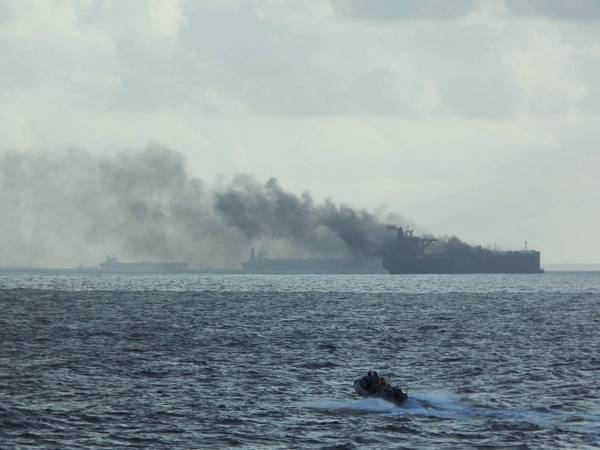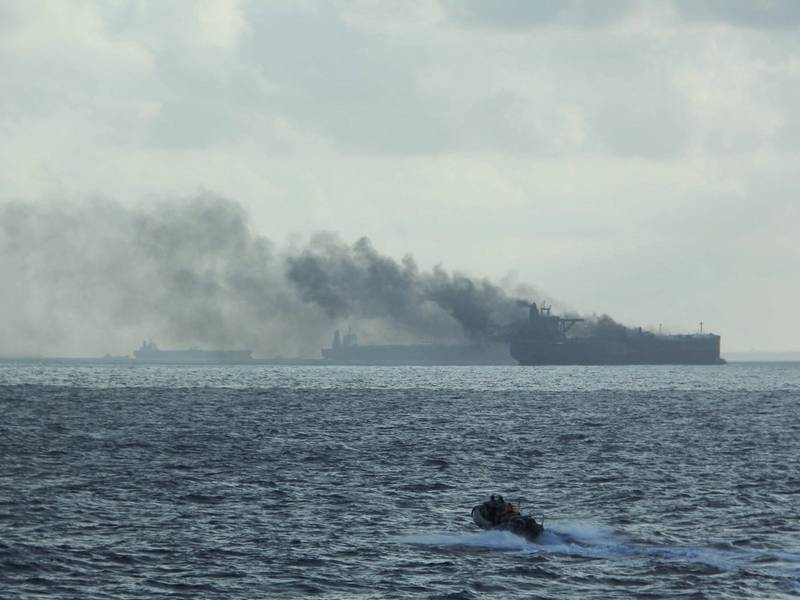A Chinese tanker linked to Iranian oil smuggling activities, was located after it was involved in a collision with a Singaporean ship on Friday.
Over the weekend, Malaysia's coast guard said it had located and intercepted Ceres I, which had collided with another vessel off Singapore, causing a fire and injuring at least two crew members. The Sao Tome and Principe-flagged supertanker was also believed to have turned off its tracking system, the coast guard said.
Despite its connection to smuggling, oil analytics firm Vortexa said that at the time of the collision, the Ceres I tanker was in ballast, indicating it was not carrying any cargo.The Iranian government also stated about a day after the collision that neither vessel had been carrying any Iranian oil at the time.
The Ceres I, a large crude-carrying supertanker with a capacity to hold 2 million barrels, controlled by China, has previously transported millions of barrels of Iranian oil.
Claire Jungman, Chief of Staff at United Against Nuclear Iran (UANI) and a specialist in monitoring suspicious oil tankers, said that since 2019, the tanker has transported at least 8 million barrels of Iranian oil and, since 2021, an additional 7.5 million barrels of Venezuelan oil.
Experts have also noted that the area where the vessel had been anchored is known to be used by so-called dark fleet ships for the illicit transfer of Iranian oil in contravention of US sanctions.
Singapore, a crucial hub for oil trading and bunkering, oversees waters essential to global trade routes linking Asia, Europe, and the Middle East.Despite international sanctions, Iran continues to export large volumes of oil, primarily through the waters of Malaysia and Singapore using illicit ship-to-ship transfers, with China being a major recipient.
The collision occurred approximately 55 km northeast of Pedra Branca, an island on the eastern approach to the Singapore Straits, according to the Maritime and Port Authority of Singapore (MPA).
In 2023, Iran shipped 670,000 barrels of oil per day to Malaysian waters, destined for Chinese refineries, according to Kpler, a leading trade intelligence firm. This volume increased to 800,000 b/d in 2024, representing over half of Iran’s total oil exports to China.
Crude oil imports from Malaysia to China surged to over 1.1 million barrels per day (mb/d) last year, a sixfold increase compared to pre-sanction levels in 2018, according to Chinese customs data.
Iran’s ‘dark fleet’
Experts say the particular vessel has a practice of turning off its tracking transponder to evade sanctions.
"The Ceres I has been a boat that has gone dark many times over the years," Matt Stanley, head of market engagement for Europe, the Middle East, Africa, and the Asia-Pacific regions at Kpler, said.
Stanley stated that the vessel's last Automatic Identification System (AIS) signal, transmitted around March, indicated it was carrying Iranian crude oil – which the US has sought to restrict by imposing sanctions on the involved ports, vessels, and refineries.
The insurance coverage for the Ceres I remains uncertain, as none of the major international P&I clubs, which collectively insure a significant portion of global maritime tonnage, provide coverage for the vessel.
Jungman estimated that around 400 foreign tankers have been involved in illegal Iranian oil shipments since the US imposed sanctions in 2018, resulting in substantial revenue losses for Iran from its oil exports. This revenue loss encompasses costs related to middlemen, clandestine operations, and discounts offered to Chinese refineries.
Referred to as "ghost ships" or "dark fleets," these vessels disguise their ownership and movements to facilitate breaches of sanctions. They engage in the risky practice of ship-to-ship transfers in the open ocean and turn off Automatic Identification System (AIS) transponders to obscure their identity. According to German insurer Allianz, these vessels have been involved in at least 50 incidents to date, including fires, engine failures, collisions, loss of steerage, and oil spills.
As a result of assistance from ghost ships, Iran's oil exports rose by about 30% to approximately 1.6 million barrels per day in the first half of 2024 compared to the same period last year, according to statistics from Kpler and Vortexa.
However, despite these efforts to circumvent sanctions, Iran lost more than one-fifth of its oil revenues in 2023, amounting to up to $6 billion, as calculated by Iran International.

